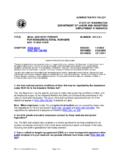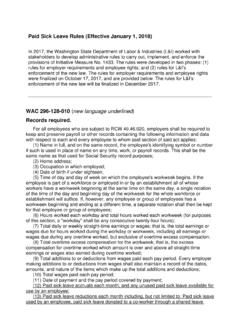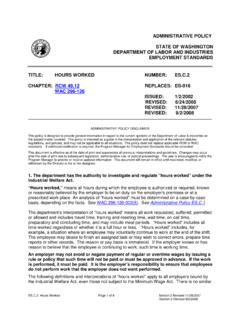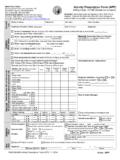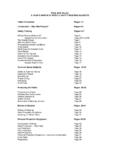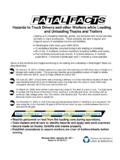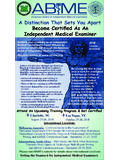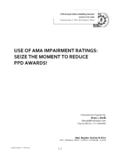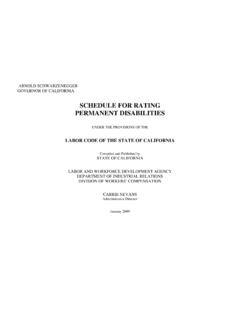Transcription of Permanent Partial Disabilities
1 Permanent Partial Disabilities Self-Insurance Claims Adjudication Guidelines Page Definition .. 3. Loss of Bodily Function .. 3. Theory of Reserve 3. Tooth Loss .. 3. PPD Ratings .. 4. Pain and PPD Awards .. 4. Who Can Rate .. 4. Rating Reports .. 5. Types of PPD Ratings .. 5. Specified PPD .. 5. Pay at the Level Rated .. 6. Unspecified PPD .. 6. Injuries on or After October 1, 1974 .. 6. Injuries July 1, 1971 through September 30, 1974 .. 7. PPD Award Limits .. 7. Self-insured Employers' Authority .. 7. Payment of PPD Awards .. 8. Timely PPD Payments .. 8. Advances .. 8. Scheduled Payments .. 8. Dates of Injury prior to June 15, 2011 .. 8. Dates of Injury on or After June 15, 2011 .. 8. Lump Sum Payments .. 9. Minor Worker.
2 9. Incarcerated 9. Deceased Worker .. 9. Liens .. 10. Board or Court Orders for PPD .. 11. PPD Awards for Mental 11. Pre-Existing Conditions .. 11. Asymptomatic Condition .. 11. Symptomatic and Disabling Condition .. 12. Additional PPD Same Claim .. 12. Permanent Partial disability June 2015 Page 1 of 14. PPD Paid Under Different 12. Remaining Amputation 13. Permanent Partial disability June 2015 Page 2 of 14. Definition Permanent Partial disability (PPD) is defined by RCW as loss of either one foot, one leg, one hand, one arm, one eye, one or more fingers, one or more toes, any dislocation where ligaments were severed where repair is not complete, or any other injury known in surgery to be Permanent Partial disability . The courts have further defined PPD to include the following: A condition arising from the injury that is fixed, lasting and stable.
3 If further improvement is possible with medical treatment, it is not a Permanent impairment. A condition can be fixed and still require palliative treatment. Any impairment of physical or mental function which detracts from the worker's physical or mental efficiency and thus hinders the worker in the ordinary pursuits of life. Loss of Bodily Function WAC 296-20-19000. PPD is based on loss of bodily function. The dollar amounts for PPD awards are set by legislature. The worker may dispute the rating itself, but not the dollar value of the rating. The amount of the PPD award is based on the schedule of benefits in effect on the date of injury. Loss of wages and other economic considerations are not taken into account in individual claims.
4 The legislature is presumed to have taken into account the general effect of specific types of injuries on wage loss when determining the PPD award schedule. Theory of Reserve Power RCW (3), WAC 296-20-220. PPD can be considered for a loss of function without disability . A worker is entitled to a PPD. award for the loss of a body part even if a remaining body part can fully cover the functional loss ( , loss of an organ not causing disability ). (Kostida v. Dept of L&I) This case denied the theory of a reserve power. In the case of body areas or systems which are category ratings or unspecified Disabilities , with the exception of loss of hearing or vision, these PPD awards are rated based on a percentage of total bodily impairment (TBI).
5 Tooth Loss PPD is paid to a worker who loses one or more teeth as a result of an industrial injury. The PPD. is awarded only for original teeth, whether or not the tooth is replaced by a bridge or denture. PPD is awarded at one-half percent TBI for each tooth lost. Permanent Partial disability June 2015 Page 3 of 14. PPD Ratings The rating of PPD is based on medical opinion in accordance with department rules (WACs), such as the category system or other nationally recognized rating systems, such as the American Medical Association (AMA) guidelines. PPD includes both objective findings and subjective symptoms caused by the injury, either directly or by aggravation. The condition(s) must be causally related to the injury on a more probable than not basis.
6 The rating does not need to include the exact terminology as written in the statute or WACs, provided it can be reasonably interpreted. Pain and PPD Awards WAC 296-20-19030. The AMA Guides to the Evaluation of PPD and the category system both incorporate subjective complaints. Subjective complaints, such as pain, cannot be objectively validated or measured. When rating PPD, reliance is primarily placed on objective findings. Who Can Rate RCW , WAC 296-20-2010. Qualified attending providers or independent medical examiners may rate a worker's impairment. The rating should not be done until treatment is completed and the condition is medically stable. Provider Type Currently Licensed In: Able to rate? Medicine and surgery Yes Osteopathic medicine and surgery Yes Podiatric medicine and surgery Yes Dentistry Yes Chiropractic Yes, if dept approved IME examiner Naturopathy No Optometry No Physicians' Assistant (PA) No Advanced Registered Nurse Practitioners (ARNP), No Including Psychiatric ARNPs If the rating is done by an independent medical examiner, the report must be sent to the attending provider for review.
7 The attending provider's opinion may, depending on the medical evidence presented, be given more weight by the Board of Industrial Insurance Appeals and Courts than one or more independent examiners. The attending provider: Permanent Partial disability June 2015 Page 4 of 14. Is presumed to be more familiar with the overall course of the injury, able to average out good days and bad days. Has to have been treating the worker for some period of time before their opinion carries greater weight. May not carry greater weight if they are not a specialist in the area of medicine involved or qualified to do rating examinations. Rating Reports WAC 296-20-2010, WAC 296-23-377. A PPD rating report must contain the following: A statement that the worker has reached maximum medical improvement and that no further curative treatment is recommended.
8 Pertinent details of the physical examination performed (both positive and negative findings). Pertinent results of any diagnostic test performed (both positive and negative findings). Include copies of any pertinent tests or studies ordered as part of the exam. A rating consistent with the findings and a statement of the system on which the rating was based ( , AMA Guide, 5th edition, category rating system). Rationale for the rating supported by objective findings. For ratings using the AMA. Guides, the rational must state the tables, figures and page numbers on which the rating was based. Types of PPD Ratings There are two types of Permanent Partial Disabilities . Specified PPD RCW Specified Disabilities are listed in RCW (1)(a).
9 They are limited to amputation or loss of function of extremities, loss of hearing or loss of vision. Impairment for the loss of function of extremities, as well as Partial loss of hearing or vision, is rated using a nationally recognized impairment rating guide (AMA Guides to the Evaluation of Permanent Impairment) unless otherwise precluded by department rule. When a specified disability is not a complete amputation or total loss of vision or hearing, the disability is rated as a percentage of impaired function as compared to an amputation or total loss of function of the ear, eye, or limb at the appropriate level (joint). Schedules for specified PPDs can be found online. Permanent Partial disability June 2015 Page 5 of 14.
10 Loss of vision is rated as a percentage of visual acuity without correction. 20/200 or greater is considered to be 100 percent loss of visual acuity. Pay at the Level Rated PPD awards must be paid at the level rated by the provider. The department prefers the rating examiner provide the PPD rating closest to the injured body part. However, it is not uncommon for some providers to rate for an entire extremity. For example: An injured worker has an ankle injury and the doctor provides a rating of 5% at the ankle (syme). The PPD would be paid at that level. An injured worker has a right knee injury and the doctor provides a rating of 2% of the right lower extremity. The PPD would be paid at the leg above the knee joint with short thigh stump.
